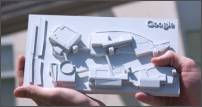 |
| The Google headquarters in 3D [Photo by Sweet Onion Creations.] |
The process starts with a very fine white powder that resembles cornstarch in consistency. The toxicity is so low that it is almost food-grade in quality. On the computer, a house or hillside is sliced up digitally and made into an outline or “pancake.” From here it is fed into the machine and each outline of that pancake traced out using a small dispenser on an “x” and “y” axis. A sugar and water binder is applied to temporarily glue each layer together.
It’s commonly referred to as an “additive process”. The best part is it generates the least waste (97% is recycled back through) which means less cost for our clients and easier on the environment.
However, the success of the architecture model hinges on a perfect “water tight” Computer Aided Design (CAD) file called a Stereolithography or STL for short. Preparing this file is typically the most tedious and difficult task of the entire process of going from 2D drawings on the computer to the 3D model in the hand. If not carefully produced, a corrupt CAD file causes the model to “blow up” in the machine and the results are fragments of building materials that simply crumble upon removal.
Sweet Onion Creations offers to turn your 3D models into reality, paid via Google Checkout, so you might want to browse the 3D Warehouse (or create your own design) if you’re looking for a unique gift.











No comments:
Post a Comment